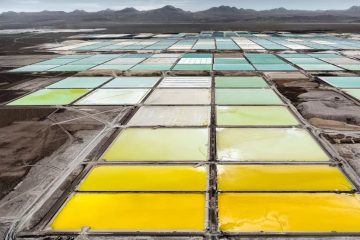Why there is such a global fascination with copper

Following a financial setback experienced by a leading copper producer, the Biden administration has engaged in discussions with potential investors regarding the possibility of acquiring a stake in the company’s Zambian mines, which are valued at up to $3 billion.
Entities from the United Arab Emirates, Japan, and Saudi Arabia, which are seen as friendly to U.S. interests, have shown interest in the stake in First Quantum Minerals’ assets, according to sources familiar with the matter. The search is not limited to American companies.
The objective is straightforward: to avoid Chinese control and hinder the Asian superpower from strengthening its hold on the worldwide supply of vital metals and minerals.
In a race to secure additional copper, which is crucial for various industries such as electric cars, transmission lines, and AI-powered data centers, the bidding process is set to be completed by the end of this year.
BHP Group’s recent unsuccessful $43 billion bid to acquire Anglo American has drawn attention to the high demand for copper in the market. London-listed Anglo produces a variety of commodities, including diamonds and nickel, while Australia’s BHP has expressed a strong interest in the company’s copper assets. Anglo rejected BHP’s initial offer last month, and it is rumored that other companies are considering competing bids.
According to sources familiar with the matter, government officials have expressed their concerns to Anglo executives regarding the potential consolidation, as it could potentially restrict the overall supply of copper. However, it is important to note that the U.S. government does not have any direct oversight over the proposed deal. There is also a concern in the U.S. that China may exert influence on BHP to divest certain assets or increase its copper sales to address potential anticompetitive issues.
From an economic perspective, the current frenzy serves as a reminder of the significance of the U.S.’s ongoing endeavor to stockpile the essential metals and minerals needed for the transition to green energy.
The demand for copper is projected to increase due to the closure or reduction in production of specific mines. The price of copper futures has increased by 20% so far this year.
The United States lacks a dedicated ministry for mining, a sovereign wealth fund, and a significant domestic mining industry. This has placed it in a less favorable position compared to China, as China has the ability to instruct its state-owned enterprises to make significant investments regardless of how commodity prices are faring.
The U.S. government has certain limitations on the amount of funds it can allocate to projects of national security. In order to achieve its goals, it is necessary for the government to collaborate with private companies both domestically and internationally. Additionally, it should establish partnerships with friendly nations that have sovereign-wealth funds, encouraging them to invest in assets that align with national interests.
According to a report by The Wall Street Journal last year, there were discussions between the U.S. and Saudi Arabia regarding potential agreements in the Democratic Republic of Congo. The discussions involved the possibility of Saudi Arabia acquiring stakes in mines, while U.S. companies would be assured certain production rights.
Amos Hochstein, a key figure in President Biden’s team, plays a crucial role in this endeavor. Hochstein and a small team at the State Department have been traveling extensively, engaging in discussions with government officials in sub-Saharan Africa one day and with U.S. investors the next.
“We don’t anticipate a significant increase in global copper supply,” stated Hochstein during an interview. It is worrisome that even after a discovery is made, it may take several years, typically between seven and 15, before the first copper production begins.
The U.S. has allocated over $1 billion to the Lobito Corridor for the purpose of enhancing local infrastructure. This includes investments in clean power and the construction of a railway that will connect Angola, Congo, and Zambia, enabling the export of vital minerals. Furthermore, in Zambia, the U.S. reportedly encouraged the U.A.E. to explore investment opportunities in Mopani Copper Mines, as per individuals with knowledge of the situation.
In December, Zambia successfully selected the U.A.E.’s International Resources Holding as their new equity partner.
Hochstein chose not to provide any details on particular transactions.
Hochstein and his team have emphasized to African governments the U.S.’s intention to present an alternative model that avoids debt, corruption, and environmental degradation.
“We are backing up our words with action,” he said.
One key aspect of the U.S. initiative is the International Development Finance Corp., a federal agency that provides financial support for projects abroad. Last year, the agency decided to increase its investment in the mining sector to $740 million, which is a significant increase from the $245 million it had previously committed to legacy mining projects.
According to insiders, discussions are underway to secure funding for a massive copper mine in Pakistan. This project, set to begin operations in 2028, has the potential to become one of the largest copper ventures globally.
TechMet, an Irish company, is one of its notable investments. Throughout the Trump and Biden administrations, the agency has provided TechMet with a substantial $105 million in funding, establishing itself as the company’s second-largest shareholder. A scion of the Walton family, along with an investment firm, also participated in the latest fundraising round, resulting in a valuation of over $1 billion for the company.
“We are currently experiencing a second Cold War,” stated Brian Menell, CEO of TechMet and a South African. It is becoming more necessary to choose sides. I have always been completely certain. There is a competition between Western values and dictatorship.
TechMet has investments in lithium, cobalt, nickel, vanadium, and rare-earth mining companies.
Meanwhile, Chinese miners, supported by government backing, are swiftly acquiring assets. In countries along the Belt and Road initiative, excluding Brazil and Australia, China’s expenditure on metals and mining investments reached over $19 billion last year. This represents a significant increase of 158% compared to 2022, as reported by the Green Finance & Development Center at Fudan University in Shanghai. This is the highest level since 2013.
According to insiders, a Chinese company is currently engaged in advanced negotiations to acquire Chemaf, a metals producer involved in the development of a cobalt and copper mine in Congo.
According to insiders, there were at least two potential buyers from the Western region who showed interest in acquiring the company. One of them is C3, a U.S. company that specializes in copper-cobalt operations in northern Chile.
Duncan Blount, the CEO of C3, mentioned that he had discussions with the International Development Finance Corp and State Department regarding a potential bid. However, he ultimately determined that the cost would have been prohibitive. However, he mentioned, “They provided invaluable assistance on this endeavor and various other initiatives.” They are eager to witness American businesses and entrepreneurs reenter Congo.


